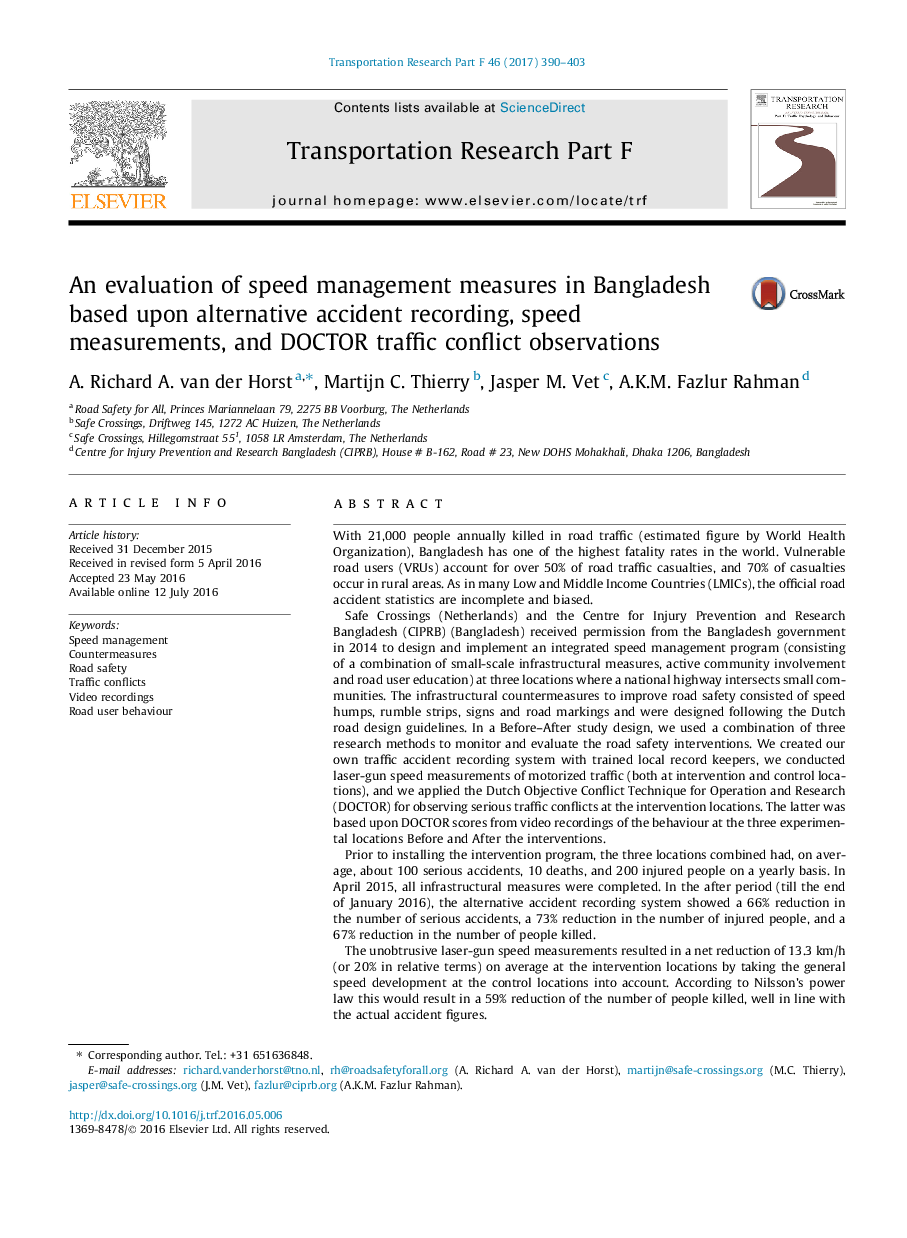| کد مقاله | کد نشریه | سال انتشار | مقاله انگلیسی | نسخه تمام متن |
|---|---|---|---|---|
| 5037386 | 1370219 | 2017 | 14 صفحه PDF | دانلود رایگان |

- 13.3Â km/h speed reduction by infrastructural measures at 3 locations in Bangladesh.
- Over 60% reduction in the number of people killed.
- Serious traffic conflicts reduced by more than 50%.
- Active community involvement and road user education included in integrated program.
- Integrated speed management program success asks for large-scale implementation.
With 21,000 people annually killed in road traffic (estimated figure by World Health Organization), Bangladesh has one of the highest fatality rates in the world. Vulnerable road users (VRUs) account for over 50% of road traffic casualties, and 70% of casualties occur in rural areas. As in many Low and Middle Income Countries (LMICs), the official road accident statistics are incomplete and biased.Safe Crossings (Netherlands) and the Centre for Injury Prevention and Research Bangladesh (CIPRB) (Bangladesh) received permission from the Bangladesh government in 2014 to design and implement an integrated speed management program (consisting of a combination of small-scale infrastructural measures, active community involvement and road user education) at three locations where a national highway intersects small communities. The infrastructural countermeasures to improve road safety consisted of speed humps, rumble strips, signs and road markings and were designed following the Dutch road design guidelines. In a Before-After study design, we used a combination of three research methods to monitor and evaluate the road safety interventions. We created our own traffic accident recording system with trained local record keepers, we conducted laser-gun speed measurements of motorized traffic (both at intervention and control locations), and we applied the Dutch Objective Conflict Technique for Operation and Research (DOCTOR) for observing serious traffic conflicts at the intervention locations. The latter was based upon DOCTOR scores from video recordings of the behaviour at the three experimental locations Before and After the interventions.Prior to installing the intervention program, the three locations combined had, on average, about 100 serious accidents, 10 deaths, and 200 injured people on a yearly basis. In April 2015, all infrastructural measures were completed. In the after period (till the end of January 2016), the alternative accident recording system showed a 66% reduction in the number of serious accidents, a 73% reduction in the number of injured people, and a 67% reduction in the number of people killed.The unobtrusive laser-gun speed measurements resulted in a net reduction of 13.3 km/h (or 20% in relative terms) on average at the intervention locations by taking the general speed development at the control locations into account. According to Nilsson's power law this would result in a 59% reduction of the number of people killed, well in line with the actual accident figures.The total number of serious conflicts (only DOCTOR scores 3, 4, and 5) was significantly reduced from 64 serious conflicts per location in a 4.5 h period Before to 29 serious conflicts in the After period, on average (Poisson distributed variable, p < 0.01), or a 55% reduction in relative terms. By including the traffic volumes, the reduction in conflict risk overall is 54%. Moreover, the severity of conflicts was reduced in the After period with only one most severe conflict (DOCTOR score 5) left. Buses represent the largest portion of road users involved in serious conflicts at all three locations, followed by cars and CNGs (Compressed Natural Gas vehicle). By far, the most frequently occurring conflict is of the type head-on conflict between an overtaking bus or car that is encountering a road user in opposite direction (for the greater part a CNG).All three evaluation measures point to a similar impact of the intervention program and unveil an improvement in road safety between 54% and 60%. The speed-reducing measures indeed considerably reduce the speed of motorized traffic, both the mean speed and 85th percentile values, both the number and severity of serious conflicts are reduced, and the actual number of accidents has decreased. It appears that Nilsson's power law for the relation between a difference in mean speed and the change in the number of accidents also applies to LMICs.Speed management measures as common in high-income countries appear to be also effective in LMICs. For evaluation purposes of road safety impacts, a Traffic Conflicts Technique approach (also developed in high-income countries) seems valid and effective as well for application in LMICs.As there are thousands of traffic black spots with similar characteristics as the three intervention locations in Bangladesh, this integrated approach may well offer similar road safety improvements elsewhere.
Journal: Transportation Research Part F: Traffic Psychology and Behaviour - Volume 46, Part B, April 2017, Pages 390-403